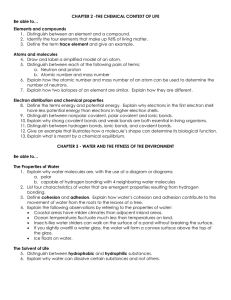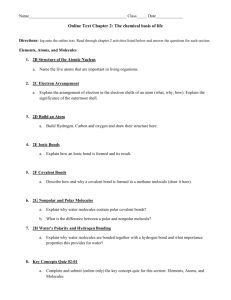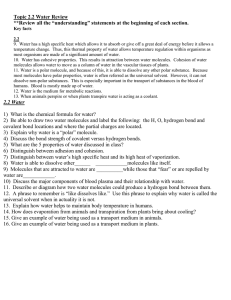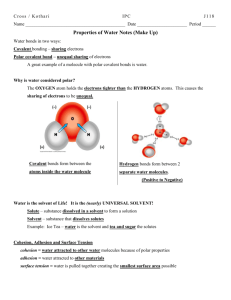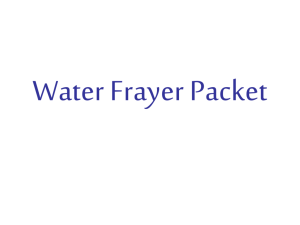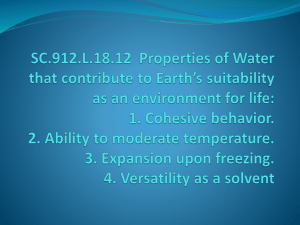Water's Life support Properties
advertisement
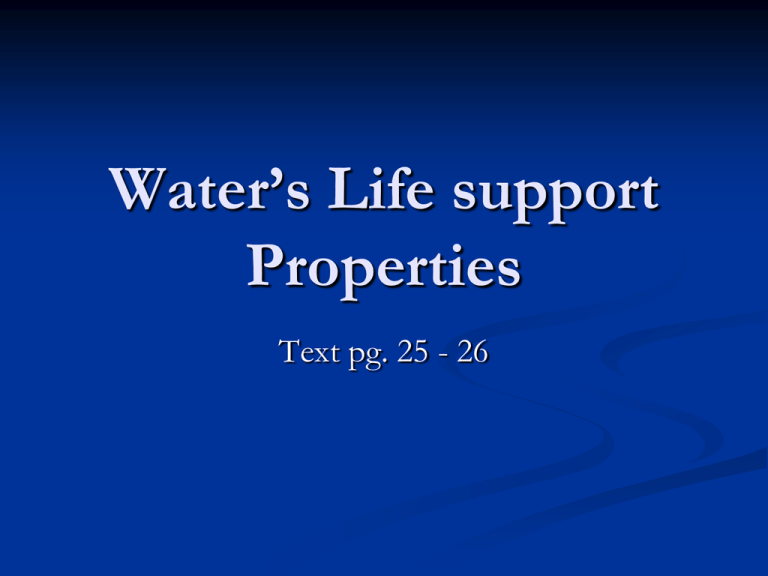
Water’s Life support Properties Text pg. 25 - 26 Polar Covalent Bonds Water has atoms with different electronegativities – – – Oxygen attracts the shared electrons more strongly than hydrogen So, the shared electrons spend more time near oxygen The result is a polar covalent bond In – H2O the oxygen atom has a slight negative charge and the hydrogens have a slight positive charge Molecules with this unequal distribution of charges are called polar molecules Hydrogen Bonds Hydrogen, within a polar covalent bond, is attracted to electronegative atoms in other molecules. – called a hydrogen bond – Is responsible for holding together 2 separate water molecules Cohesion Hydrogen bonding causes molecules to stick together, a property called cohesion Cohesion is related to surface tension - a measure of how difficult it is to break the surface of a liquid – Hydrogen bonds are responsible for surface tension Adhesion Adhesion is the clinging of one substance to another unlike itself. Caused by adhesion the water runs along the glass and does not fall straight. Capillary Action is a result of a combination of cohesion and adhesion Capillary Action is the ability of water to flow up a thin tube against gravity It is due to a combination of cohesion and adhesion Examples: Water soaking up a paper towel Water turning up the side of a test tube Capillary action is the mechanism behind transpiration Transpiration is the process by which water is pulled from the roots of a plant all the way up and out of the leaves. Adhesion Cohesion Direction of water movement Water-conducting cells Water - The Universal Solvent Solvent – liquid that can dissolve other substances Solute – substance that dissolves in a solvent HYDROPHILIC (WATER LOVING) SUBSTANCES Ionic substances are soluble (they dissolve) in water because the poles of the polar water molecules interact with the ionic substances and separate them into ions. Polar covalent substances are also soluble of the interaction with their poles with water HYDROPHOBIC (WATER HATING) SUBSTANCES Nonpolar covalent substances do not dissolve in water because they lack charged poles EX. WATER AND OIL BOTTLES Water’s hydrogen bonds moderate temperature Has a greater ability to resist temperature change because of hydrogen bonds. – Heat is the energy associated with movement of atoms and molecules in matter – Temperature measures the intensity of heat ***** When it is cool outside, water will be warmer than the air. When it is warm outside, the water will be colder than the air. Specific Heat Capacity Specific heat capacity – the degree to which a substance changes temperature in response to a gain or loss of heat Water has a high specific heat, with so many hydrogen bonds between water molecules, it can absorb a great deal of heat, with only a slight temperature change. Compare the water in a pool on a hot day, and a metal chair next to the pool Heat of fusion and heat of vaporization When water changes physical states, from solid to liquid or liquid to gas, energy is absorbed but the water temperature remains constant. The absorbed energy is used only to change the physical state of the water by breaking the hydrogen bonds that tether the water molecules together. In the reverse reactions, from gas to liquid or liquid to solid, the energy released reestablishes the hydrogen bonds. Heat of fusion and heat of vaporization Ice Most types of matter are more dense as a solid Water is different in that when water freezes, each molecule forms a stable hydrogen bond with four neighbors – A three-dimensional crystal results – There is space between the water molecules (This is not the case with most solids. This is the reason why you can bite into and break ice.) Ice is less dense than water, so it floats Ice Water molecules Are spaced out Liquid water Water molecules are closer together

